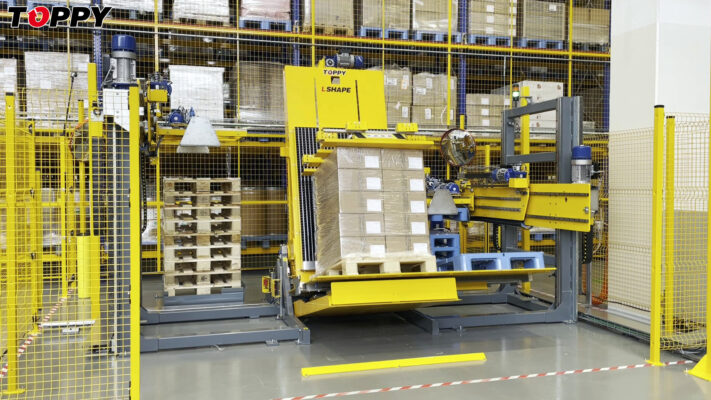The process of automation of unloading pallets for your incoming materials is also called depalletizing. Such robot depalletizer or robotic depalletizing systems are usually designed for handling virtually any kind of pallet configuration, packaging type, or product mix and can help eliminate the following issues that are generally seen with manual unloading processes.
- Ergonomic
- Safety
- Availability of labor
Top Industries can offer a robot depalletizer system for your warehouse operation customized to your requirements.
Depalletizing in warehouse and distribution
Cost reduction and increased production throughput are the two main goals of operational efficiencies. Robot depalletizer is an essential part of the ongoing battle to combat supply chain challenges and preserve healthy margins.
These days, it is difficult to obtain manual labor, there are a lot of turnovers, training costs are high, and ergonomic issues cause unnecessary injuries.
The depalletizing of pallets is one of the important aspects of warehouse automation which is full of incoming products that are ready for redistribution to certain smaller retail outlets or any end customers.
A robot depalletizer and de-palletizers can automate labor as well as time-intensive tasks efficiently within manufacturing, distribution, and other fulfillment applications.


Robot depalletizer solutions
There are only a few businesses that specialize in using robot depalletizer. Robots make excellent use of tiny spaces, can handle a wide variety of SKUs with little to no changeovers, and have amazing reliability with little to no maintenance.
These depalletizing solutions can handle a wide range of product types such as from flexible packaging, like bales and bags to any rigid packaging, such as boxes, totes, pails, jugs, or drums, having end effectors made specifically for each solution.

What are the benefits with a robot depalletizer?
- Safe working environment
The risky nature of its operations, like those of any transportation company, results in a disproportionately high accident rate. The Health and Safety Executive estimates that 52,000 employees were actually dealing with work-related illnesses.
Companies’ costs for accident claims, safety training, and regulatory compliance are increased by these human workers at risk, which eventually results in a high turnover rate.
When handling items weighing more than 20 kg, this exhausting chore may prove to be hazardous. However, automating this procedure creates a far more secure working environment.
2020 will see a huge increase in e-commerce, which will lead to a huge increase in SKU variation. The growing pandemic increased the requirement for manual labor in American warehouses to $1.2 million.
Layer pickers were required to put in extra hours of work and were always under pressure to lift objects of all different sizes, shapes, and weights. Social segregation and quarantine policies turned out to be yet another significant barrier for businesses, compounding the problem of a labor shortage.
Automated roboti depalletizer can increase productivity, lower operating costs, and make the workplace safer, regardless of whether a business handles mixed-SKU pallets or several pallets of the same SKU.
The warehouse workforce also has the chance to recover from chronic illnesses, accidents, and other health problems brought on by this demanding work. The business can profit from both artificial and human cognitive intelligence by automating the depalletizing process.
- Low turnover rate
Businesses that automate their depalletizing procedures might anticipate low turnover. Simply put, they use robots that never sleep or grow tired.
The confusion between employees and businesses regarding the benefits and drawbacks of such automated solutions, however, is a significant underlying issue.
According to research, more than 70% of Americans are worried about being replaced by robots. These employees are ignorant of the many benefits that automation offers, and in many cases, their positions will be changed rather than eliminated.
Strong depalletizing cells in warehouses can use the specified area, both the floor as well as vertical space, more effectively than warehouse employees can.
It improves overall performance by allowing manual workers to concentrate on other tasks that offer value.
Modern robotic de-palletizers have a gripper for pick-and-place depalletizing activities and 3D vision systems. They are made up of several cameras, vision applications, and laser sensors.
Such a system calculates the coordinates of items that are randomly put while simultaneously capturing the environment. It provides a reliable method for choosing and placing ambiguous objects of different heights by enabling the robot to scan each object, identify their pick point, and arrange them on a conveyor belt.
A box with tapes can be recognized by the depalletizing cell as a single object rather than as six independent boxes.
By utilizing state-of-the-art vision software, picking objects of different sizes from a random stack is made possible for the robots.
While performing quality checks, some vision software supports object classification and segmentation to handle objects differently.
- Streamlined process
Thanks to AI-driven vision techniques and machine-learning algorithms, robotics can unload multiple items or shiny products with ease.
A robotic palletizer is able to manage a continuous flow of mixed-SKU pallets in any order thanks to this sophisticated vision software.
Robots can move more quickly in difficult surroundings thanks to the vision software, which classifies and offers over 100 grip postures per second using a trained neural network.
In general, it reduces frequent manual handling errors while also maintaining a steady throughput rate. Depalletizing is now more easily automated than it was previously.
Warehouses can now use an appropriate robotic depalletizing cell equipped with a state-of-the-art vision system and an appropriate gripper to lift the biggest of objects thanks to deep-learning algorithms.
These changes will enhance the overall working environment for employees and offer a flexible automated remedy to the extraordinarily dynamic logistics sector.
Based on the weight, size, throughput, and other physical attributes of the product which are handled, robot depalletizer can be developed for your operations so that it will offer you an effective and fast system that can provide impressive reliability also with minimal maintenance.
